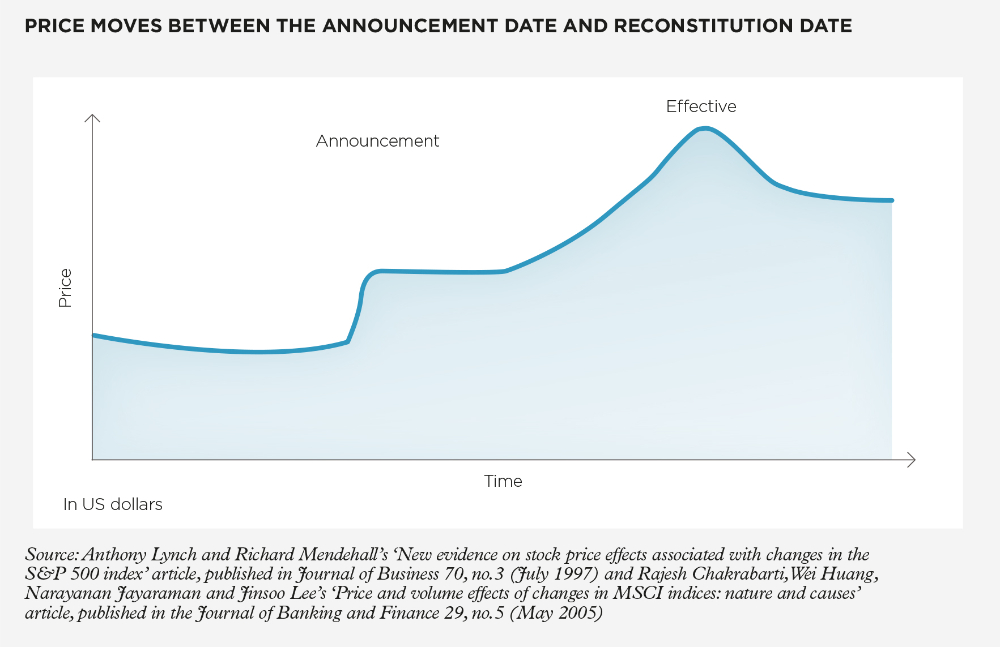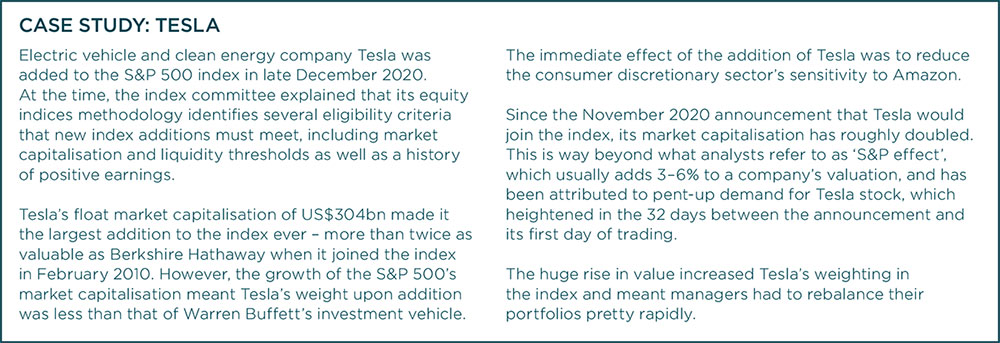We explore how global indices are constructed and how big index events impact fund managers
by Paul Golden
On 18 December 2020, the last day of trading before Tesla joined the S&P 500 on 21 December, its share price surged from US$655 the day before to US$695. On 26 January 2021, its share price reached a record high of US$883, although it plunged to US$563 on 8 March 2021 and is now slowly increasing (as of 20 April 2021). This major index event is a timely reminder of the challenges faced by index fund managers – see case study below.
"Index funds are designed to track the performance of a market index. To do this, the fund manager purchases all the securities in the index or a representative sample of them … so that the performance of the fund tracks the value of the index," according to the 2020 Fact book by the Investment Company Institute, a global association representing regulated funds.
At the end of 2019, index mutual funds and exchange-traded funds (ETFs) accounted for 39% of the US$22tn in long-term funds in the US, according to the 2020 Fact book. Index funds collectively represented 15% of total US stock market capitalisation, it says.
While figures for mutual funds and ETFs are available, the value of the overall passive investment sector is impossible to calculate, as it is conducted within a range of vehicles by a range of investor types, not all of whom report their assets under management.
(Click to enlarge)

Index funds and ETFs employ three main tracking methodologies:
-
Full replication – where all the constituents of the underlying index are held in the same proportions as the index.
-
Optimised or sampled – where only part of the index is owned, which may be because there are illiquid holdings in the index that would be difficult and costly to trade, or where excluding certain holdings would have very little impact on the tracking performance.
-
Synthetic replication – where a type of derivative called a total return swap is used to gain the performance of the index.
"Both equity and bond ETFs/indices predominantly select underlying constituents based on their market caps," says Lynn Hutchinson, senior collectives analyst (passives) at wealth management firm Charles Stanley. "Over the past few years, ETF equity products in particular have expanded and there are now many that move away from just market cap selection to offer factors such as value, quality, and sustainability." Fixed income ETFs are still dominated by market cap weighting selections.
"Fixed income index-tracking funds and ETFs tend to be largely optimised/sampled as this reduces transaction costs"
Tim Edwards, managing director of index investment strategy at S&P Dow Jones Indices, adds that most equity indices use a float-adjusted market capitalisation weighting. "In less technical terms, they reflect the performance of a whole market, weighted by the proportion of capital invested in each stock," he says.
However, there are a number of differences between the various indices, including:
- Length of live publication history and degree of consistency in methodology. (Has the index design changed over time? How much of the history is real-time rather than back-testing?)
- Breadth and depth. (Does the index contain constituents from just one country or many? Does it contain all the stocks in a given market or just the largest?)
- Selection criteria. (For a company’s stock to join the S&P Composite 1500, that company must have reported a profit over the past 12 months – a condition that is not required in order to join, for example, the Russell 3000.)
- Reconstitution. (Does the index rebalance on an as-needed basis or a predetermined schedule?)
- Country and sector classifications. (Index providers do not universally agree on which countries should be classified as emerging or developed.)
- Independence. (Is the index published and maintained by an independent third party or by a provider of financial products tracking the same index?)
It's important for investors to understand the way indices differentiate from each other, from construction to rules, methodologies to different approaches. For example, the S&P 500 is independently calculated and maintained by the Index Committee pursuant to a transparent methodology, unlike the MSCI USA index, for instance. MSCI classifies South Korea as an emerging market country, whereas FTSE classifies it as a developed country.
Index rules can also change. In November 2020, revised rules were published for the DAX index in Germany, which has meant that since December 2020, all DAX candidates must have a positive earnings before interest, taxes, depreciation and amortisation in their two most recent annual financial statements. Since March 2021, all companies in the DAX Selection Indices have the obligation to publish audited annual financial reports and quarterly statements.
Index events
Apart from the Tesla inclusion to the S&P 500, "Other recent index events requiring index-tracking portfolio managers to make material changes include the sector reclassifications of 2018 (when communication services replaced telecoms) and 2016, when real estate investment trusts were promoted from a subset of financials to their own sector," says Tim.
"This required significant adjustments in the portfolios of sector-based funds in particular," continues Tim. "These events largely confirmed the abilities of fund sponsors to manage significant changes at the index level without causing disruption to the markets."
The 2018 sector reclassification was part of what became known as the ‘defanging’ of the S&P 500, a process designed to reduce the influence of big tech stocks, such as Alphabet and Facebook, on the index.
How closely an index-tracking product matches the performance of the index it tracks will depend on three factors:
- Its ongoing charges/total expense ratios
- The efficiency of its tracking methodology
- The impact of any remunerative activities it is engaged in, such as stock lending.
"Fixed income index-tracking funds and ETFs tend to be largely optimised/sampled as this reduces transaction costs," explains Lynn. "There is a lower weighting in small-cap assets as these can be costly to trade and difficult to source."
Large-cap and most mid-cap equities tend to be fully replicated, especially in developed markets. "Small-caps tend to be optimised due to the cost of including every equity in the fund and also the fact that they may be hard to obtain," adds Lynn.
The high-level objectives for index managers are much the same across all asset classes – to deliver a risk return commensurate with the benchmark. However, the key risks and the accessibility of the underlying assets are very different.
"In the equity space you are looking at country risk, industry risk and stock-specific risk," explains David Barron, head of index equity and smart beta at Legal & General Investment Management. "Because equities are a liquid and transparent asset class, transacting in the marketplace is a bit easier – if the index is telling us to hold 500 names, we will hold close to all of these names."
"These passive investors typically have to acquire a pro rata exposure to that company by the inclusion date"
On the fixed income side, the benchmark composition tends to be quite different because the number of bonds available is so much larger and it is, therefore, harder to hold every name. As a result, managers tend to make more use of proxies.
Rebalancing is managed by assessing expected changes in supply-demand. "We do this by applying the index’s published rules to assess likely entrances and exits for various indices and pre-positioning the portfolio to take advantage of these moves," says David. "It is about becoming familiar with the index methodology, what constitutes a change, what would warrant a change and the types of corporate events that trigger changes, and assessing how to leverage this knowledge."
So, what is the role of indices in driving performance of stocks? When a stock is selected for inclusion, it comes onto the radar of passive investors who replicate the index, explains Daniel Broby, senior knowledge exchange Fellow in the accounting and finance department of University of Strathclyde Glasgow. "These passive investors typically have to acquire a pro rata exposure to that company by the inclusion date," he says. "The price impact is generally favourable as there is increased demand for the stock, while the converse is true for removal from an index."

However, Tim points out that for the vast majority of the indices published by S&P Dow Jones, selection has no discernible effect on price.
He refers to research published in the Journal of index investing in November 2019. The authors find it corroborates earlier findings that the index effect is no longer significant for the S&P 500 and has weakened significantly for the Russell 1000 and Russell 2000 indexes, although it remains present in the global indices, particularly the MSCI World Small Cap and MSCI Emerging Markets indices.
Perhaps the best way to think about how managers weigh up tracking difference versus trading/tax costs is that if there is a new fixed income issue that will be added to the index, they consider the tracking error risk of not adding it to the portfolio.
